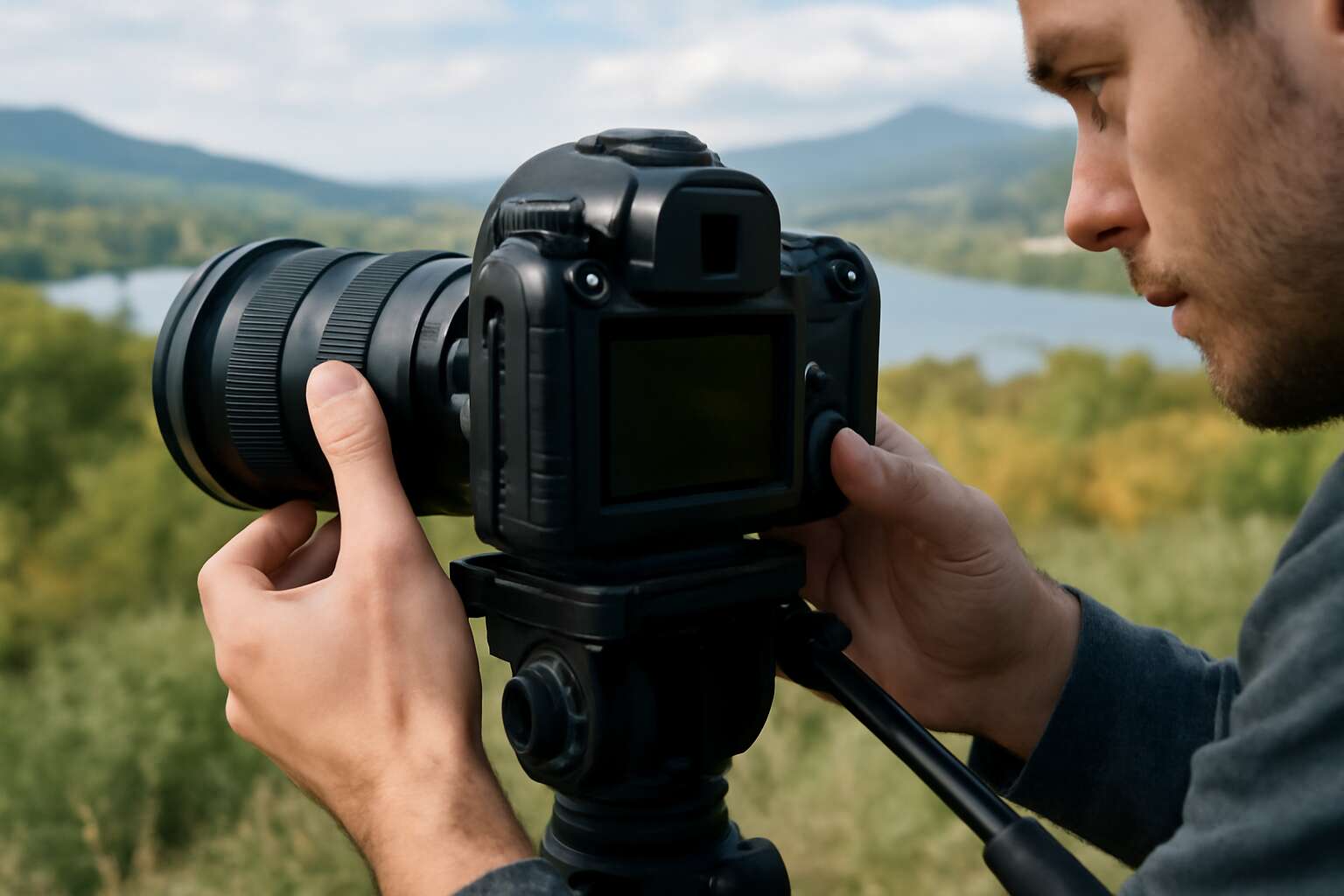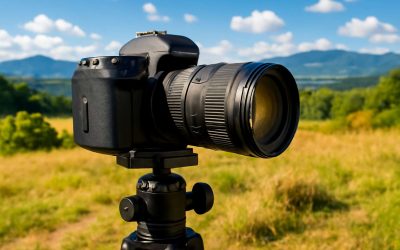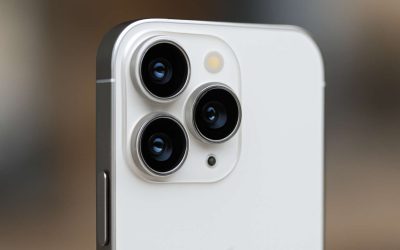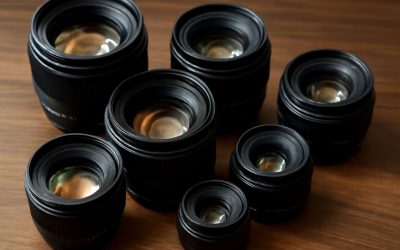Understanding DSLR Cameras with Video Capabilities
Overview of DSLR Cameras – Key features and advantages of DSLR cameras
In the realm of digital photography, few tools combine versatility and quality quite like the DSLR camera with video capabilities. These devices have revolutionised the way creators capture both stills and motion, offering a seamless transition between photography and videography. A well-designed DSLR camera with video features ensures filmmakers and hobbyists alike can produce cinematic results without sacrificing image quality.
When exploring DSLR cameras with video capabilities, key features such as interchangeable lenses, manual controls, and high-resolution sensors stand out. These elements allow for precise adjustments to exposure, focus, and depth of field—crucial for creating compelling visual stories. Additionally, many models boast advanced autofocus systems and built-in microphones, boosting overall production value.
Advantages of choosing a DSLR camera with video extend beyond flexibility. Their larger sensors produce cleaner images with impressive low-light performance, and the optical viewfinder provides a more natural shooting experience. Whether capturing intricate landscapes or dynamic interviews, the robust build and professional-grade features make DSLR cameras an indispensable tool for serious content creators.
Why Choose a DSLR for Video – Benefits over mirrorless and compact cameras
In a world obsessed with instant gratification, a DSLR camera with video capabilities remains the Swiss Army knife of digital imaging. Unlike their mirrorless or compact counterparts, DSLRs offer a unique blend of optical excellence and tactile control that makes even the most mundane shot feel like a work of art. They’re the trusted choice for serious videographers craving depth of field, superior low-light performance, and the ability to swap lenses faster than you can say “cinematic masterpiece”.
What truly sets a DSLR camera with video apart is its innate versatility. While mirrorless cameras may boast sleeker profiles and compactness, DSLRs bring a level of robustness and professional-grade features that can handle the rigours of high-stakes productions. The larger sensors not only enhance image quality but also afford creative control over focus and exposure, giving filmmakers and hobbyists alike the power to craft visually stunning stories.
And let’s not forget the tactile experience—there’s something undeniably satisfying about adjusting manual focus rings or tweaking aperture dials in real time. For those seeking to elevate their craft, a DSLR camera with video is an investment in precision, durability, and that elusive ‘cinematic’ feel. It’s the reason why many still prefer them over more modern, but less tactile, alternatives.
Key Video Features to Look For – Autofocus, frame rate, resolution, and stabilization
In the realm of professional storytelling, a dslr camera with video capabilities is an instrument of profound artistry, demanding a nuanced understanding of its core features. Among these, autofocus is paramount—offering the precision necessary to capture fleeting moments with unwavering clarity. A smooth, reliable autofocus system can transform a simple shot into an evocative visual narrative, especially when paired with high frame rates that breathe life into motion.
Resolution, another pillar of quality, dictates the clarity and detail that elevate a project from ordinary to extraordinary. Modern dslr cameras with video often support 4K or even higher, enabling filmmakers to craft cinematic visions with razor-sharp fidelity. Stabilisation technology, whether optical or digital, ensures that even handheld shots maintain a polished, professional appearance, reducing the need for extensive post-production correction.
- High frame rate recording for slow-motion effects and dynamic action sequences.
- Advanced autofocus with face and eye detection for seamless focus shifts.
- Superior resolution that captures every nuance of colour and texture.
- In-built stabilisation systems to maintain shot stability across challenging terrains.
When selecting a dslr camera with video, these features are not mere luxuries but essential tools for realising creative visions. They unlock a world of possibility—allowing creators to push boundaries and craft compelling, visually stunning stories that resonate deeply with audiences. Every element, from autofocus to stabilisation, contributes to the immersive experience that only a high-calibre DSLR can deliver in the video domain.
Top Features to Consider in a DSLR Camera with Video
Video Resolution and Frame Rates – 1080p vs 4K, slow motion capabilities
In the shadowed corridors of modern filmmaking, the choice of resolution and frame rates can transform a simple scene into an epic tableau of motion and emotion. A high-quality dslr camera with video capability offers more than mere clarity — it immerses the viewer in a visceral experience. While 1080p resolution remains the stalwart, whispering promises of sharpness and detail, the allure of 4K beckons with fourfold the visual fidelity, capturing intricate textures and subtle nuances that elevate storytelling to a realm beyond the mundane.
Slow motion capabilities are another facet of the dark arts, allowing filmmakers to dissect time itself, revealing the beauty hidden within fleeting moments. When selecting a dslr camera with video, consider the frame rates — 24p for cinematic grace, or 60p and above for action-packed sequences. These choices shape the mood, tone, and impact of your visual narrative, making the camera not just a tool, but a conduit for your creative soul.
Autofocus Technology – Dual Pixel AF, face detection, eye tracking
When it comes to capturing cinematic moments, a DSLR camera with video capabilities must excel at more than just recording in high resolution. Top-tier autofocus technology is the secret sauce that keeps your subjects sharp, whether they’re dancing, running, or sneaking around in dimly lit corridors. Features like Dual Pixel AF offer lightning-fast focus transitions, making your footage look professional without the need for bulky rigs or post-production magic. It’s almost like having a second pair of eyes — one that’s laser-focused on your subject’s face or even their eye, thanks to face detection and eye tracking.
These intelligent autofocus features are a game-changer for videographers who crave seamless focus shifts. For example, eye tracking ensures your subject’s gaze stays locked, even as they turn, tilt, or do a spontaneous dance move. Such precision prevents the frustrating “focus hunting” that can turn a well-planned shot into an unintentional comedy. When selecting a dslr camera with video, look for models that combine these advanced autofocus features with smooth, reliable operation — because nothing ruins a good take faster than a focus that’s too slow or jittery.
In the world of professional videography, the autofocus system is often the unsung hero. A well-designed autofocus can be the difference between a captivating story and a forgettable flick. Plus, with features like customizable focus points and sensitive tracking, you can craft shots that feel organic and deliberate, all within your DSLR camera with video. Whether you’re filming a fast-paced action scene or a delicate, intimate interview, these autofocus technologies elevate your storytelling to new heights.
Image Stabilization – In-body vs lens-based stabilization systems
In the realm of capturing cinematic brilliance, the stability of your footage can make or break the viewer’s immersion. When selecting a DSLR camera with video capabilities, understanding the nuances of image stabilization becomes paramount. At its core, stabilization shields your shots from the inevitable tremors of hand-held shooting, transforming shaky footage into smooth, flowing visuals. The debate often centres around in-body versus lens-based stabilisation systems, each with its own poetic strengths.
In-body stabilisation (IBIS) works silently within the camera’s heart, adjusting sensor position to counteract every jitter and shake. It’s a versatile marvel, harmonising with a range of lenses and offering a unified stabilisation solution. Conversely, lens-based stabilisation (OIS or optical image stabilisation) resides within the lens itself, providing targeted correction at the point of capture. This system excels with telephoto lenses, where even the slightest tremor can distort the frame.
- In-body stabilisation offers a broader, more adaptable shield against camera shake, especially when paired with prime or vintage lenses.
- Lens-based systems tend to be more effective for zoomed-in shots, as they provide precise correction tailored to the lens’s optical path.
Choosing between these systems hinges on your shooting style and the kinds of scenes you aim to immortalise. Both approaches serve as an invisible guardian for your cinematic visions, elevating your dslr camera with video from mere recording device to storytelling instrument of impeccable clarity. With each frame rendered steady and true, your audience is invited to experience every fleeting moment with a clarity that feels almost tangible—an artistry only a truly stabilised DSLR camera with video can deliver.
Low Light Performance – ISO range and sensor sensitivity
When capturing moments in the shadows, the true test of a DSLR camera with video lies in its low light performance. The secret ingredient? An expansive ISO range paired with a highly sensitive sensor — the unsung heroes that enable your footage to shine even after sunset. A broad ISO spectrum, from 100 to 25,600 or beyond, allows you to adapt swiftly to changing lighting conditions without sacrificing clarity.
Beyond just numbers, the sensor’s ability to handle noise determines the cinematic quality of your videos in dim environments. Modern DSLR cameras with video incorporate advanced technologies, such as dual gain sensors, that preserve detail while minimising grain. In low light, every pixel counts, and a sensor with heightened sensitivity captures more light, unlocking a universe of visual storytelling possibilities in darkness.
In the quest for perfect footage, pay close attention to the camera’s ISO performance. Some models even feature extended ISO capabilities, giving you a tactical edge when shooting in unpredictable lighting. Whether you’re capturing a moody night scene or an indoor event, the right DSLR camera with video will be your steady ally, transforming shadows into a canvas of rich, cinematic depth.
Best DSLR Cameras with Video in 2024
Budget-Friendly Options – Affordable models with solid video features
Budget-friendly doesn’t have to mean sacrificing quality—especially when it comes to a DSLR camera with video capabilities. In 2024, there are several affordable models that deliver impressive video features without draining your wallet. Whether you’re a hobbyist venturing into vlogging or an aspiring filmmaker, these options prove that you can get cinematic results on a budget.
For instance, some of the best DSLR cameras with video in this price range offer 1080p resolution with high frame rates and excellent autofocus technology. You might not get 4K at every price point, but many models still provide slow-motion capabilities and good in-body image stabilization, ensuring your footage remains smooth and professional-looking. Plus, in low light situations, these cameras perform admirably, thanks to improved sensor sensitivity.
- Solid video features for beginner and intermediate users
- Affordable price tags that won’t break the bank
- Reliable autofocus with face detection and eye tracking
Choosing the right dslr camera with video in 2024 is about balancing performance with affordability. Luckily, the market offers several options that strike this perfect chord, making it easier than ever to shoot stunning videos without splurging on top-tier gear.
Mid-Range Choices – balanced features and performance for enthusiasts
In 2024, the mid-range DSLR camera with video capabilities has become a game-changer for enthusiasts seeking a perfect balance between performance and affordability. These models deliver robust features that elevate your videography without the hefty price tag, making them ideal for serious hobbyists and aspiring content creators alike. With advancements in autofocus technology and image stabilisation, capturing cinematic footage has never been easier or more reliable.
Many mid-range options boast impressive 1080p resolution with high frame rates, ensuring your videos are smooth and vivid. Some models even offer 4K recording, providing the flexibility to create professional-grade content. A standout feature across these cameras is Dual Pixel autofocus, which guarantees sharp focus during dynamic shots, complemented by face detection and eye tracking for effortless focus on moving subjects.
For those craving stability on the move, in-body image stabilisation systems help reduce camera shake, transforming shaky footage into polished scenes. Whether shooting in low-light environments or bright conditions, these cameras perform admirably thanks to enhanced sensor sensitivity and ISO ranges. The right DSLR camera with video in this mid-range bracket opens up a world of creative possibilities—without the need for a Hollywood budget.
Premium DSLR Models – Top-tier options for professional videographers
For professional videographers seeking the pinnacle of DSLR technology in 2024, premium DSLR models stand as the gold standard. These high-end cameras don’t just capture moments—they craft cinematic experiences with exceptional clarity and depth. The latest offerings combine advanced autofocus systems, robust image stabilisation, and stunning high-resolution video capabilities, making them essential tools for those pushing the boundaries of visual storytelling.
Models such as the Canon EOS-1D X Mark III and Nikon D6 exemplify this excellence, offering features like 4K recording at high frame rates, dual pixel autofocus, and superior low-light performance. These cameras are designed to perform under demanding conditions, ensuring every shot is sharp and beautifully rendered. Their durable build and extensive ISO ranges empower videographers to shoot seamlessly across diverse environments—whether in bustling city streets or quiet rural landscapes.
Several of these premium DSLR cameras with video also include built-in features that streamline the creative process, such as customizable picture profiles, high-bit-rate recording, and advanced audio inputs. For those who demand nothing but the best, these models offer a blend of technological sophistication and artistic freedom that transforms raw footage into compelling stories. Truly, they are the workhorses of professional videography, capable of turning every frame into a masterpiece.
Comparison Chart – Quick comparison of key specs and prices
In a landscape where visual storytelling is more vital than ever, choosing the right DSLR camera with video capabilities in 2024 can seem overwhelming. With an explosion of options, a quick comparison chart becomes an essential tool to navigate the myriad of models and their specifications. Whether you’re a seasoned professional or an enthusiastic creator, understanding key differences—such as resolution, frame rate, and autofocus technology—can help you make an informed decision.
Below is a streamlined comparison of some of the leading DSLR cameras with video on the market today:
- Canon EOS-1D X Mark III — Renowned for its robust build and exceptional 4K recording, it offers dual pixel autofocus and a high ISO range for low-light versatility.
- Nikon D6 — Features superior low-light performance, a fast frame rate for smooth motion, and extensive audio input options for professional-grade sound capture.
- Canon EOS 90D — An excellent mid-range choice, combining 4K video with in-body stabilisation and a user-friendly interface for hobbyists transitioning into professional videography.
Prices vary significantly, with premium models reaching higher investment levels, but they often come with advanced features like high-bit-rate recording and customisable picture profiles. For those seeking a balance of performance and affordability, mid-range options deliver compelling video capabilities without breaking the bank. Ultimately, selecting the best DSLR camera with video depends on your unique needs, whether it’s capturing cinematic moments or documenting everyday stories with clarity and depth.
Essential Accessories for Shooting Video with a DSLR
Lenses for Video – Prime vs zoom lenses, recommended focal lengths
Choosing the right lenses for your dslr camera with video capability can dramatically influence your final footage. When it comes to lenses for video, the debate between prime and zoom lenses is ongoing. Prime lenses, with their fixed focal lengths, offer exceptional sharpness, wider apertures, and superior low-light performance. They are perfect for creating cinematic depth of field and capturing stunning bokeh effects. Conversely, zoom lenses provide versatility, allowing videographers to quickly adjust framing without changing lenses — an invaluable trait when filming dynamic scenes or in unpredictable environments.
For most video projects, recommended focal lengths depend on the style and setting. Wide-angle lenses (around 24mm to 35mm) excel for landscapes or establishing shots, whereas mid-range focal lengths (50mm to 85mm) are ideal for interviews and close-ups. Telephoto zooms (70mm to 200mm) are excellent for capturing distant subjects while maintaining a natural perspective. Whether you opt for prime or zoom lenses, understanding their unique attributes will help you craft compelling visuals with your dslr camera with video.
External Microphones – Improving audio quality with shotgun and lapel mics
In the realm of cinematic storytelling, sound often emerges as the invisible force shaping the emotional resonance of footage. When using a DSLR camera with video capabilities, investing in high-quality external microphones becomes paramount; they elevate your production from amateurish to polished. Shotgun mics, with their directional sensitivity, capture crisp dialogue and ambient sounds, minimising unwanted background noise. Lapel microphones, discreet and close-proximity, are ideal for interviews and vlogs, ensuring clear audio even in bustling environments.
For seamless integration, consider mounting options that preserve your camera’s manoeuvrability while maintaining optimal sound fidelity. A well-chosen external microphone can drastically improve the overall quality of your footage, transforming raw recordings into immersive visual stories. Remember, even the most stunning visuals can be undermined by poor audio—so prioritise your sound setup when filming with your dslr camera with video.
Stabilizers and Tripods – Gimbals, monopods, and professional tripods
When venturing into the realm of cinematic storytelling, a steady hand and balanced composition are essential—yet often overlooked are the unsung heroes: stabilisers and tripods. For your dslr camera with video capabilities, choosing the right accessory can elevate your footage from shaky amateurism to smooth, professional-grade visuals. Gimbals, with their advanced motion-smoothing technology, allow for fluid movement, even when walking or running, creating an almost hypnotic cinematic experience.
Alternatively, monopods and professional tripods offer stability and flexibility, especially in dynamic shooting environments. For those seeking versatility, an ol of options can be helpful:
- Gimbals for seamless, cinematic camera movement
- Monopods for quick setup and mobility
- Sturdy tripods for static shots with impeccable stability
Each of these essential accessories for shooting video with a DSLR camera with video unlocks creative potential—ensuring your visual stories are captured with clarity and grace. Stability isn’t just a technical requirement; it’s the foundation of captivating storytelling. When paired with the right stabiliser or tripod, your dslr camera with video becomes a portal to worlds unseen, where every frame sings with purpose and precision.
Lighting Equipment – LED panels, softboxes, and reflectors
In the shadowed corridors of cinematic creation, lighting is the unseen sorcerer that transforms fleeting moments into enduring legends. For your dslr camera with video capabilities, selecting the right lighting equipment can elevate your visuals from mere pixels to pulsating works of art. LED panels, softboxes, and reflectors serve as the silent muses, shaping the mood and tone with subtle finesse. An LED panel, with its adjustable brightness and colour temperature, grants control over the atmosphere—casting shadows or illuminating faces with equal grace.
Softboxes diffuse harsh light into a gentle glow, perfect for creating that hauntingly natural look that captivates viewers. Reflectors, on the other hand, act as mirrors of the moon—bouncing ambient light back into shadowed corners, revealing hidden details and adding depth to each frame. To truly harness these tools, consider a layered approach: combining LED panels with softboxes for soft, controlled illumination or using reflectors to add dimension without extra power sources. Such accessories are not merely technical add-ons; they are the conduits through which your dslr camera with video reveals its full storytelling potential—casting shadows and light as if conjuring spirits from the ether, whispering tales in every frame.
Tips and Tricks for Shooting Professional Quality Video
Manual Settings Tips – Controlling exposure, white balance, and focus
Mastering manual settings on your dslr camera with video is essential for capturing professional-quality footage. Precise control over exposure, white balance, and focus allows videographers to craft visually stunning narratives that resonate with viewers. When adjusting exposure, utilise the camera’s histogram to prevent blown-out highlights or murky shadows, ensuring a balanced image. White balance calibration is equally vital; setting it manually or using presets tailored to your lighting conditions will maintain colour accuracy and mood consistency throughout your shoot.
Focusing remains one of the most critical elements; employing techniques like focus pulling or using autofocus features such as Dual Pixel AF can elevate your video’s cinematic feel. Remember, controlling these settings with confidence transforms a basic shot into a compelling story. For seamless operation, consider customising your dslr camera with video to include quick-access buttons for exposure, white balance, and focus adjustments. This approach makes real-time tweaks more intuitive and helps maintain continuity across scenes, elevating your craft from amateur to professional.
Composition and Framing – Rules of thirds, camera movement, and shot types
Capturing cinematic footage with a DSLR camera with video is a delicate dance of composition and finesse. The rules of thirds remain the guiding star—placing your subject off-centre creates visual intrigue and balance that keeps viewers hooked. Thoughtful camera movement, whether subtle pan or dynamic dollies, can breathe life into your scenes, transforming flat shots into immersive experiences.
Understanding shot types—wide, medium, close-up—enables you to tell your story with precision. For instance, a well-chosen close-up can reveal raw emotion, while a sweeping wide shot establishes context. Incorporating smooth camera movements, such as tilt or tracking, enhances narrative flow and elevates your production to professional heights.
Remember, mastering these aspects of shooting with a dslr camera with video isn’t just about technical proficiency; it’s about crafting a visual language that resonates. When framing your scenes with intention and finesse, your footage will not only meet but exceed the expectations of discerning viewers.
Post-Processing – Video editing software recommendations and color grading
In the pursuit of cinematic excellence, post-processing becomes the crucible where raw footage is transformed into compelling visual narratives. A high-quality dslr camera with video capabilities provides a robust foundation, but the real magic unfolds during editing. Selecting the right video editing software can make all the difference; options such as Adobe Premiere Pro, DaVinci Resolve, and Final Cut Pro X offer sophisticated tools for refining colour, stabilising footage, and synchronising audio seamlessly.
Colour grading, in particular, elevates your footage, imbuing scenes with mood and personality. Subtle adjustments to contrast, saturation, and tone can evoke profound emotional responses, turning ordinary shots into cinematic masterpieces. To streamline your workflow, consider applying colour presets or creating custom LUTs—look-up tables—that maintain consistency across your project.
For those aiming to craft professional quality videos with a dslr camera with video, mastering both editing software and colour grading is essential. Remember, the journey from captured footage to polished film hinges on your ability to marry technical finesse with artistic vision—an endeavour that rewards patience, experimentation, and a keen eye for detail.
Troubleshooting Common Issues – Focus hunting, rolling shutter, audio sync
Capturing stunning footage with a dslr camera with video is a craft that demands precision and patience. Yet, even seasoned videographers encounter hurdles—focus hunting, rolling shutter effects, and audio sync issues can turn a smooth shoot into a frustrating puzzle. The key lies in understanding these common problems and knowing how to troubleshoot them effectively.
Focus hunting is often caused by inadequate autofocus settings or challenging lighting conditions. To mitigate this, switch to manual focus or utilise advanced autofocus features like Dual Pixel AF for rapid, accurate focus shifts. Rolling shutter, on the other hand, results from fast camera movements when recording with a dslr camera with video. Using a camera with a global shutter or stabilising your shots with gimbals can significantly reduce this distortion. For audio sync issues, ensure your audio recording device and camera are timecode-synced or use external audio recorders—this can save hours of post-production frustration.
To streamline your workflow, consider these troubleshooting steps:
- Test your camera’s autofocus settings in different lighting conditions to prevent focus hunting.
- Use stabilisation accessories such as gimbals or monopods to combat rolling shutter effects during dynamic shots.
- Regularly monitor audio levels and sync external microphones properly to avoid audio lag or mismatch.
Mastering these techniques with your dslr camera with video ensures your footage remains crisp, steady, and immersive—transforming potential pitfalls into opportunities for creative storytelling rather than technical setbacks. After all, even the most sophisticated gear requires a keen eye and a steady hand to unlock its full cinematic potential!




0 Comments